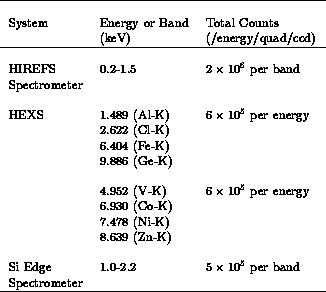


Next: 4.2 Sample results from
Up: 4 Spectral Response Function
Previous: 4 Spectral Response Function
A typical CCD spectral response function is illustrated in Figure 3. This pulse-height spectrum was obtained from a flight-candidate
device using a radioactive Fe source,
which produces characteristic K and L X-rays of Mn at 5.9, 6.4 and 0.65 keV;
only events in which the charge is confined to precisely one or two pixels
(so-called one- and two-pixel events) are included in the histogram.
The various parameters to be constrained by the spectral response function
measurements are indicated in the figure. These include the location and
asymmetric shape of the primary photopeak, the magnitude of the Si K-escape and
fluorescence features, and the amplitude and shape of the extended low-energy
tail. For the spectrum shown, about
2.5% of the events occur outside of the primary photopeaks.
The magnitude of the various features of the spectral response function
depend on a variety of
parameters, including X-ray energy, detector operating temperature and
bias levels, and event selection criteria.
source,
which produces characteristic K and L X-rays of Mn at 5.9, 6.4 and 0.65 keV;
only events in which the charge is confined to precisely one or two pixels
(so-called one- and two-pixel events) are included in the histogram.
The various parameters to be constrained by the spectral response function
measurements are indicated in the figure. These include the location and
asymmetric shape of the primary photopeak, the magnitude of the Si K-escape and
fluorescence features, and the amplitude and shape of the extended low-energy
tail. For the spectrum shown, about
2.5% of the events occur outside of the primary photopeaks.
The magnitude of the various features of the spectral response function
depend on a variety of
parameters, including X-ray energy, detector operating temperature and
bias levels, and event selection criteria.
The objective of the spectral response function measurements is to constrain
the various response function components as functions of these parameters.
The specific accuracy
objectives of the measurements are as follows:
- Determine the energy scale (that is, the relationship between input X-ray energy,
in eV, and photopeak location, in engineering units) with an error less than 0.1%, and
line full-width at half maximum (FWHM) with an error less than 5%.
- Determine magnitude secondary peak features (Si K-escape, Si-K fluorescence)
to
 of total flux.
of total flux.
- Determine the magnitude of the low-energy tail with an accuracy
 of main peak (error in integrated tail area : integrated main peak flux).
of main peak (error in integrated tail area : integrated main peak flux).
Some details of the spectral response function measurements made for
nominal operating conditions are listed in
Table 1. Reflection-grating spectrometers are used to
sample the response function nearly continuously with incident energy below
2 keV. Discrete characteristic lines are used at higher energies. The
apparatus used to make these measurements are described in
other contributions to these proceedings [5,6].
Note that each ACIS CCD contains four output amplifiers, and each of these
amplifiers serves one (rectangular) quadrant of the device.
Table 1 lists the number of counts obtained for each CCD quadrant.

Table 1: Spectral Response Function Measurements



Next: 4.2 Sample results from
Up: 4 Spectral Response Function
Previous: 4 Spectral Response Function
mwb@space.mit.edu
 source,
which produces characteristic K and L X-rays of Mn at 5.9, 6.4 and 0.65 keV;
only events in which the charge is confined to precisely one or two pixels
(so-called one- and two-pixel events) are included in the histogram.
The various parameters to be constrained by the spectral response function
measurements are indicated in the figure. These include the location and
asymmetric shape of the primary photopeak, the magnitude of the Si K-escape and
fluorescence features, and the amplitude and shape of the extended low-energy
tail. For the spectrum shown, about
2.5% of the events occur outside of the primary photopeaks.
The magnitude of the various features of the spectral response function
depend on a variety of
parameters, including X-ray energy, detector operating temperature and
bias levels, and event selection criteria.
source,
which produces characteristic K and L X-rays of Mn at 5.9, 6.4 and 0.65 keV;
only events in which the charge is confined to precisely one or two pixels
(so-called one- and two-pixel events) are included in the histogram.
The various parameters to be constrained by the spectral response function
measurements are indicated in the figure. These include the location and
asymmetric shape of the primary photopeak, the magnitude of the Si K-escape and
fluorescence features, and the amplitude and shape of the extended low-energy
tail. For the spectrum shown, about
2.5% of the events occur outside of the primary photopeaks.
The magnitude of the various features of the spectral response function
depend on a variety of
parameters, including X-ray energy, detector operating temperature and
bias levels, and event selection criteria.
 of total flux.
of total flux.
 of main peak (error in integrated tail area : integrated main peak flux).
of main peak (error in integrated tail area : integrated main peak flux).
